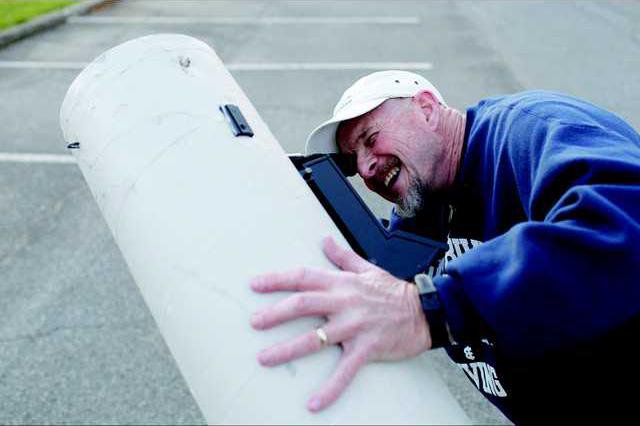When most people think of science, they imagine sitting in a classroom, memorizing the periodic table of elements, creating volcanos out of papier–mâché or reciting the planets backward and forward.
Frank Lock doesn’t see it that way.
“Science is a verb,” he said. “Science is something people do.”
For him, science is about getting your hands dirty and experiencing it for yourself. However, most people don’t have the opportunity. And it is one of the reasons why he loads his pickup truck with three telescopes any chance he can to bring science to the masses.
“All I need is a little excuse to do something,” the 65-year-old said.
One upcoming excuse is the unusual event of the transit of Mercury, which is when the smallest planet travels across the path between the Earth and sun and creates a small black shadow over a small portion of it. Lock will head out May 9 to Chestatee High School to show students the planetary event.
Lock’s love of astronomy first popped up when his wife bought him a telescope in 1975. From its lenses, he viewed Saturn and was awed by what he saw.
“I just wanted to learn more,” he said.
Now, he teaches others what he has learned. And it appears an easy task for the former high school teacher.
Lock taught physics, chemistry and astronomy for 35 years and ran an Astronomy Club through the school. He is also a member of the Network of Educator Astronaut Teachers, a group of schoolteachers who were chosen by NASA to spread their educational efforts.
He started his Telescopes in the Park events in April 2010, after moving to Gainesville from Florida six months earlier. He hosted the same kind of events in Florida, where students, faculty and parents would come to learn.
He conducts the Telescopes in the Park “whenever he has an excuse.” For his meetups, interested stargazers are required to wear weather-appropriate clothing and bring bug spray in the summertime.
Lock is not alone in his appreciation of the stars and planets in Northeast Georgia.
Joseph Jones runs the University of North Georgia’s planetarium in Dahlonega. The associate professor of physics uses the 25-year-old facility for his astronomy-based classes. He teaches courses such as introduction to astronomy to unveil the ideas of science to college students. Most students who take his courses are usually not science majors, he said.
“You can talk about every big science idea,” he said, noting his classes include topics from the Big Bang to orbiting planets to chemistry.
He said he tries to teach science in an approachable way and caters to students who are not majoring in the topic.
“They know what biology looks like, from high school, but they don’t know what an astronomy class looks like,” Jones said.
Through his teaching, he hopes they become interested in science and have a “lifelong appreciation for science.”
Helping people appreciate the science are weekly shows inside the planetarium, also known as the George E. Coleman Sr. Planetarium. The free shows are at 8 p.m. every Friday in Room 234 in the school’s Health and Natural Sciences Building.
Other events are planned, including the upcoming transit of Mercury. No details of the event were available at press time.
Other shows for school children or large groups can be purchased for $85 and usually run on Thursdays.
Shows are exhibited with the new Digistar 5 Full Dome Digital Planetarium Projector, which was installed 18 months ago. The new projector offers an easier way to see stars and planets, while offering the traditional view.
In the old planetarium, changing the view was difficult since it was more or less an old-fashioned model. The light bulb in the center of a dome had to be moved manually to view a different angle or different star.
The new machine “just takes just the click of a mouse,” Jones said.
It has a database of the “known universe,” he said, which allows viewers to fly to Jupiter, or any other planet and galaxies. The old way was two-dimensional, while the new planetarium offers a 3D view of the solar system.
And Lock enjoys spreading the science of the stars to all generations at the planetarium.
“Good science education is really important to our culture,” Lock said. “I enjoy working at helping folks understand how important it is.”

